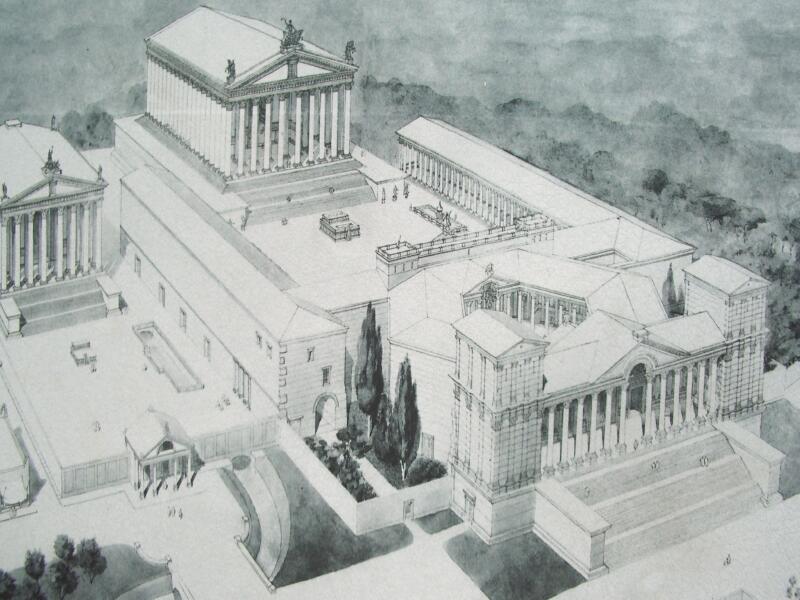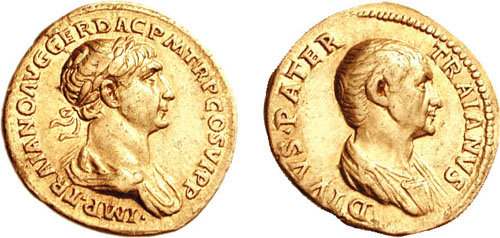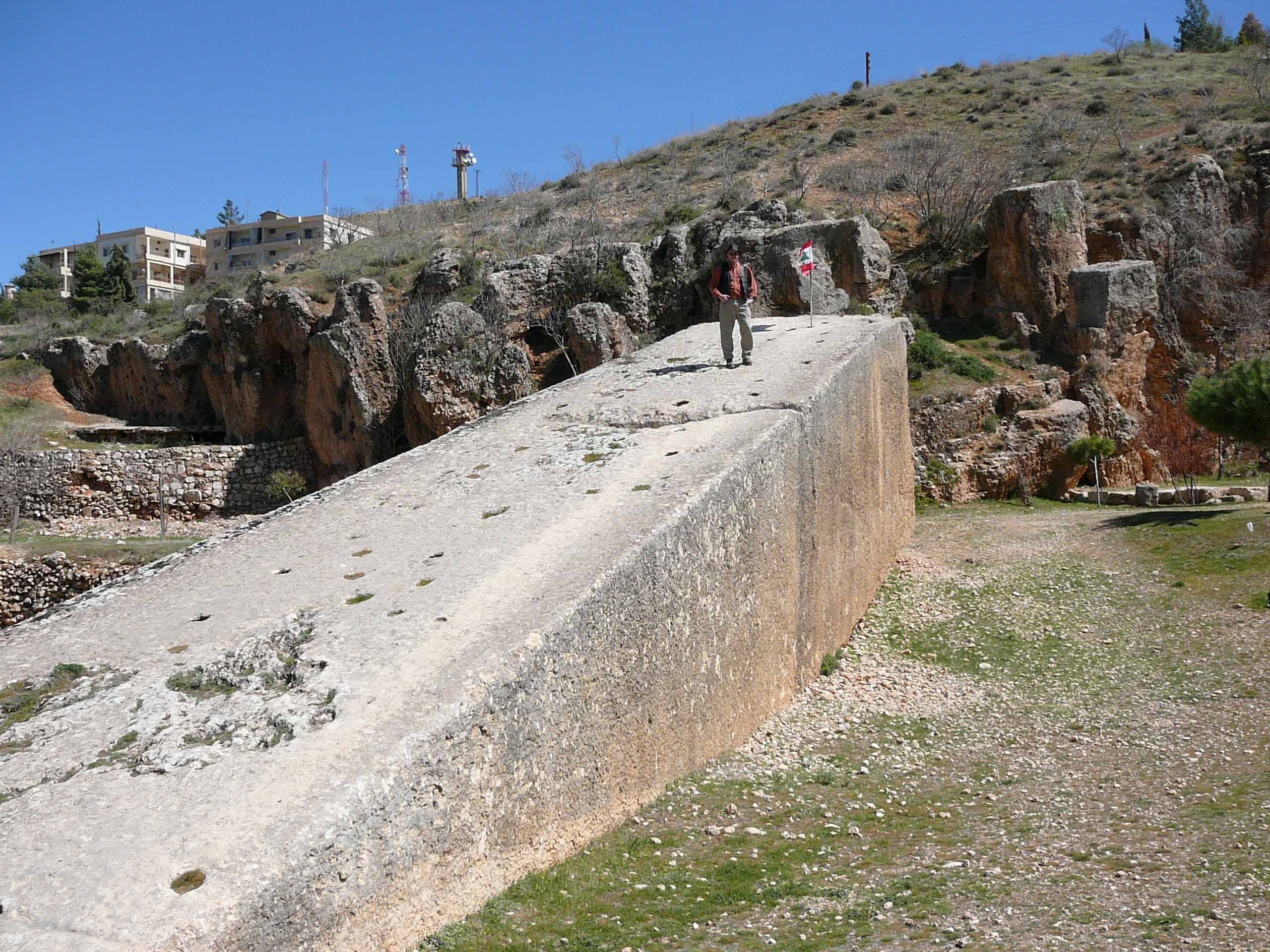|
Temple Of Jupiter (Roman Heliopolis)
The Temple of Jupiter is a colossal Roman temple in Baalbek, Lebanon. It is the largest of the Roman world after the Temple of Venus and Roma in Rome. It is unknown who commissioned or designed the temple, nor exactly when it was constructed. It is most likely construction begun in the first century BC. It is situated at the western end of the Great Court of Roman Heliopolis, on a broad platform of stone raised another above the huge stones of the foundation, three of which are among the heaviest blocks ever used in a construction. Cultic activity had long taken place at the site; the temple presumably replaced an earlier one, possibly using the same foundation. It was the biggest temple dedicated to Jupiter Optimus Maxiums Heliopolitanus in all the Roman Empire. The columns were 19.9 meters high with a diameter of nearly 2.5 meters: the biggest in the classical world. It took three centuries to create this colossal temple complex. History The huge quarry nearby likely played i ... [...More Info...] [...Related Items...] OR: [Wikipedia] [Google] [Baidu] |
Roman Temple
Ancient Roman temples were among the most important buildings in culture of ancient Rome, Roman culture, and some of the richest buildings in Architecture of ancient Rome, Roman architecture, though only a few survive in any sort of complete state. Today they remain "the most obvious symbol of Roman architecture".Summerson (1980), 25 Their construction and maintenance was a major part of Religion in ancient Rome, ancient Roman religion, and all towns of any importance had at least one main temple, as well as smaller shrines. The main room ''(cella)'' housed the Cult (religious practice), cult image of the List of Roman deities, deity to whom the temple was votum, dedicated, and often a table for supplementary offerings or libations and a small altar for incense. Behind the cella was a room, or rooms, used by temple attendants for storage of equipment and offerings. The ordinary worshiper rarely entered the cella, and most public ceremonies were performed outside of the cella ... [...More Info...] [...Related Items...] OR: [Wikipedia] [Google] [Baidu] |
Trajan
Trajan ( ; born Marcus Ulpius Traianus, 18 September 53) was a Roman emperor from AD 98 to 117, remembered as the second of the Five Good Emperors of the Nerva–Antonine dynasty. He was a philanthropic ruler and a successful soldier-emperor who presided over one of the greatest military expansions in Roman history, during which, by the time of his death, the Roman Empire reached its maximum territorial extent. He was given the title of ('the best') by the Roman Senate. Trajan was born in the of Italica in the present-day Andalusian province of province of Seville, Seville in southern Spain, an Italic peoples, Italic settlement in Hispania Baetica; his came from the town of Todi, Tuder in the Regio VI Umbria, Umbria region of central Italy. His namesake father, Marcus Ulpius Traianus (father of Trajan), Marcus Ulpius Traianus, was a general and distinguished senator. Trajan rose to prominence during the reign of Domitian; in AD 89, serving as a in , he supported t ... [...More Info...] [...Related Items...] OR: [Wikipedia] [Google] [Baidu] |
Nero
Nero Claudius Caesar Augustus Germanicus ( ; born Lucius Domitius Ahenobarbus; 15 December AD 37 – 9 June AD 68) was a Roman emperor and the final emperor of the Julio-Claudian dynasty, reigning from AD 54 until his death in AD 68. Nero was born at Antium in AD 37, the son of Gnaeus Domitius Ahenobarbus (father of Nero), Gnaeus Domitius Ahenobarbus and Agrippina the Younger (great-granddaughter of the emperor Augustus). Nero was three when his father died. By the time Nero turned eleven, his mother married Emperor Claudius, who then Adoption in ancient Rome, adopted Nero as his heir. Upon Claudius' death in AD 54, Nero ascended to the throne with the backing of the Praetorian Guard and the Senate. In the early years of his reign, Nero was advised and guided by his mother Agrippina, his tutor Seneca the Younger, and his praetorian prefect Sextus Afranius Burrus, but sought to rule independently and rid himself of restraining influences. The power ... [...More Info...] [...Related Items...] OR: [Wikipedia] [Google] [Baidu] |
Julio-Claudian Emperors
The Julio-Claudian dynasty comprised the first five Roman emperors: Augustus, Tiberius, Caligula, Claudius, and Nero. This line of emperors ruled the Roman Empire, from its formation (under Augustus, in 27 BC) until the last of the line, Emperor Nero, committed suicide (in AD 68). The name ''Julio-Claudian'' is a historiographical term, deriving from the two families composing the imperial dynasty: the Julii Caesares and Claudii Nerones. Nomenclature ''Julius'' and ''Claudius'' were two Roman family names; in classical Latin, they came second. Roman family names were inherited from father to son, but a Roman aristocrat could—either during his life or in his will—adopt an heir if he lacked a natural son. In accordance with Roman naming conventions, the adopted son would replace his original family name with the name of his adopted family. A famous example of this custom is Julius Caesar's adoption of his great-nephew, Gaius Octavius. Primogeniture is notably absent in th ... [...More Info...] [...Related Items...] OR: [Wikipedia] [Google] [Baidu] |
Didyma
Didyma (; ) was an Ancient Greece, ancient Greek sanctuary on the coast of Ionia in the domain of the famous city of Miletus. Apollo was the main deity of the sanctuary of Didyma, also called ''Didymaion''. But it was home to both of the Ancient Greek temple, temples dedicated to the twins Apollo and Artemis. Other deities were also honoured within the sanctuary. The Didymaion was well renowned in antiquity because of its famed oracle. This oracle of Apollo was situated within what was, and is, one of the world's greatest temples to Apollo. The remains of this Hellenistic period, Hellenistic temple belong to the best preserved temples of classical antiquity. Besides this temple other buildings existed within the sanctuary which have been rediscovered recently; a Theatre of ancient Greece, Greek theatre and the foundations of the above-mentioned Hellenistic temple of Artemis, to name but two. Geography The ruins of Didyma are located a short distance to the northwest of modern Di ... [...More Info...] [...Related Items...] OR: [Wikipedia] [Google] [Baidu] |
Ephesus
Ephesus (; ; ; may ultimately derive from ) was an Ancient Greece, ancient Greek city on the coast of Ionia, in present-day Selçuk in İzmir Province, Turkey. It was built in the 10th century BC on the site of Apasa, the former Arzawan capital, by Attica, Attic and Ionians, Ionian Greek colonists. During the Classical Greece, Classical Greek era, it was one of twelve cities that were members of the Ionian League. The city came under the control of the Roman Republic in 129 BC. The city was famous in its day for the nearby Temple of Artemis (completed around 550 BC), which has been designated one of the Seven Wonders of the Ancient World. Its many monumental buildings included the Library of Celsus and a theatre capable of holding 24,000 spectators. Ephesus was a recipient city of one of the Pauline epistles and one of the seven churches of Asia addressed in the Book of Revelation. The Gospel of John may have been written there,Stephen L Harris, Harris, Stephen L., ''Under ... [...More Info...] [...Related Items...] OR: [Wikipedia] [Google] [Baidu] |
Temple Of Artemis
The Temple of Artemis or Artemision (; ), also known as the Temple of Diana, was a Greek temple dedicated to an ancient, localised form of the goddess Artemis (equated with the Religion in ancient Rome, Roman goddess Diana (mythology), Diana). It was located in Ephesus (near the modern town of Selçuk in present-day Turkey). It is believed to have been ruined or destroyed by AD 401. Only foundations and fragments of the last temple remain at the site. The earliest version of the temple (a Bronze Age ''temenos'') antedated the Ionic immigration by many years. Callimachus, in his ''Hymn to Artemis'', attributed it to the Amazons. In the 7th century BC, it was destroyed by a flood. Its reconstruction, in more grandiose form, began around 550 BC, under Chersiphron, the Cretan architect, and his son Metagenes. The project was funded by Croesus of Lydia, and took 10 years to complete. This version of the temple was destroyed in 356 BC by an arsonist, commonly thought to have ... [...More Info...] [...Related Items...] OR: [Wikipedia] [Google] [Baidu] |
Greeks
Greeks or Hellenes (; , ) are an ethnic group and nation native to Greece, Greek Cypriots, Cyprus, Greeks in Albania, southern Albania, Greeks in Turkey#History, Anatolia, parts of Greeks in Italy, Italy and Egyptian Greeks, Egypt, and to a lesser extent, other countries surrounding the Eastern Mediterranean and Black Sea. They also form a significant Greek diaspora, diaspora (), with many Greek communities established around the world.. Greek colonies and communities have been historically established on the shores of the Mediterranean Sea and Black Sea, but the Greek people themselves have always been centered on the Aegean Sea, Aegean and Ionian Sea, Ionian seas, where the Greek language has been spoken since the Bronze Age.. Until the early 20th century, Greeks were distributed between the Greek peninsula, the western coast of Asia Minor, the Black Sea coast, Cappadocia in central Anatolia, Egypt, the Balkans, Cyprus, and Constantinople. Many of these regions coincided to ... [...More Info...] [...Related Items...] OR: [Wikipedia] [Google] [Baidu] |
Pediment
Pediments are a form of gable in classical architecture, usually of a triangular shape. Pediments are placed above the horizontal structure of the cornice (an elaborated lintel), or entablature if supported by columns.Summerson, 130 In ancient architecture, a wide and low triangular pediment (the side angles 12.5° to 16°) typically formed the top element of the portico of a Greek temple, a style continued in Roman temples. But large pediments were rare on other types of building before Renaissance architecture. For symmetric designs, it provides a center point and is often used to add grandness to entrances. The cornice continues round the top of the pediment, as well as below it; the rising sides are often called the "raking cornice". The tympanum is the triangular area within the pediment, which is often decorated with a pedimental sculpture which may be freestanding or a relief sculpture. The tympanum may hold an inscription, or in modern times, a clock face. ... [...More Info...] [...Related Items...] OR: [Wikipedia] [Google] [Baidu] |
Corinthian Column
The Corinthian order (, ''Korinthiakós rythmós''; ) is the last developed and most ornate of the three principal classical orders of Ancient Greek architecture and Roman architecture. The other two are the Doric order, which was the earliest, followed by the Ionic order. In Ancient Greek architecture, the Corinthian order follows the Ionic in almost all respects, other than the capitals of the columns, though this changed in Roman architecture. A Corinthian capital may be seen as an enriched development of the Ionic capital, though one may have to look closely at a Corinthian capital to see the Ionic volutes ("helices"), at the corners, perhaps reduced in size and importance, scrolling out above the two ranks of stylized acanthus leaves and stalks ("cauliculi" or ''caulicoles''), eight in all, and to notice that smaller volutes scroll inwards to meet each other on each side. The leaves may be quite stiff, schematic and dry, or they may be extravagantly drilled and undercut, n ... [...More Info...] [...Related Items...] OR: [Wikipedia] [Google] [Baidu] |
Peristyle
In ancient Ancient Greek architecture, Greek and Ancient Roman architecture, Roman architecture, a peristyle (; ) is a continuous porch formed by a row of columns surrounding the perimeter of a building or a courtyard. ''Tetrastoön'' () is a rarely used archaic term for this feature. The peristyle in a Greek temple is a ''peristasis (architecture), peristasis'' (). In the Christian Church architecture, ecclesiastical architecture that developed from the Roman basilica, a courtyard peristyle and its garden came to be known as a cloister. Etymology The Greek word περίστυλον ''perístylon'' is composed of περί ''peri'', "around" or "surrounded", and στῦλος ''stylos'', "column" or "pillar", together meaning "surrounded by columns/pillars". It was Latinised into synonyms ''peristylum'' and ''peristylium''. In Greek architecture A peristyle was mostly used as a courtyard in Ancient Greece, but in the homes of people who were in the upper class or if they owned s ... [...More Info...] [...Related Items...] OR: [Wikipedia] [Google] [Baidu] |
Stone Of The Pregnant Woman
The Baalbek Stones are six massive Ancient Roman architecture, Roman worked stone blocks in Baalbek (ancient Heliopolis), Lebanon, characterised by a megalithic gigantism unparallelled in Classical antiquity, antiquity. How the stones were moved from where they were quarried to their final locations is uncertain. The smaller three are part of a podium wall in the Roman temple, Roman complex of the Temple of Jupiter (Roman Heliopolis), Temple of Jupiter Baal (Heliopolitan Zeus) are known as the "Trilithon". Each of these is estimated at . The quarry was slightly higher than the temple complex, so no lifting was required to move the stones. The large stones may have been moved into position on rollers along temporary earthen banks from the quarry. The remaining three are Roman monoliths, not part of a larger structure, conventionally known as the "Stone of the Pregnant Woman" (estimated at 1,000 t), the "Stone of the South" (est. 1,242 t), and the "Forgotten Stone" (est. 1,650 t). T ... [...More Info...] [...Related Items...] OR: [Wikipedia] [Google] [Baidu] |









